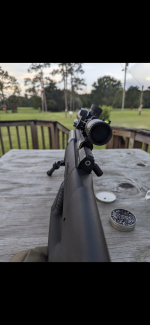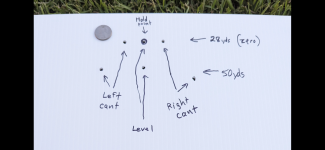For this little test, I used a .177 Brocock Bantam with Atlas Bipod and Athlon Midas Tac 6-24 x 50(with bubble level) shooting JSB Monsters @ 820 fps.
I place a target at 28 yards(zero distance) with a dot in the center. I used this dot as a holdpoint on all shots fired.
I leveled the gun and fired a shot at the dot, hitting it in the center. I then canted the gun all the way to the left(15°) and fired a shot, hitting an inch to the left of the holdpoint dot. I then canted all the way to the right (15°) and fired a shot, hitting an inch to the right of the holdpoint dot.
I then moved the target to 50 yards and repeated this procedure.


I place a target at 28 yards(zero distance) with a dot in the center. I used this dot as a holdpoint on all shots fired.
I leveled the gun and fired a shot at the dot, hitting it in the center. I then canted the gun all the way to the left(15°) and fired a shot, hitting an inch to the left of the holdpoint dot. I then canted all the way to the right (15°) and fired a shot, hitting an inch to the right of the holdpoint dot.
I then moved the target to 50 yards and repeated this procedure.

